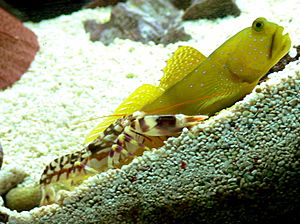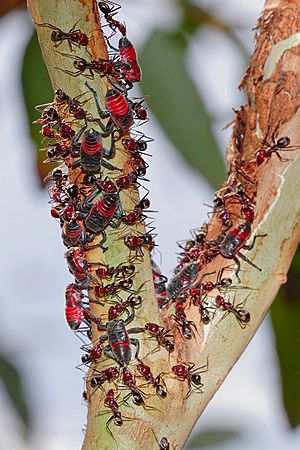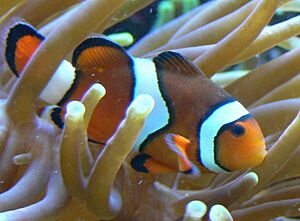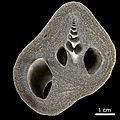Symbiosis facts for kids
Symbiosis means "living together." It describes a close and long-term relationship between two different species. These relationships can be incredibly diverse, ranging from partnerships where both organisms benefit greatly, to situations where one benefits at the expense of the other, or even where one is unaffected.
An organism living in a symbiotic relationship is called a symbiont. If one species lives inside another, like tiny organisms living inside the cells of a host, it's called an endosymbiont.
Symbiosis is very common and important for how life on Earth has evolved. Most plants and animals have symbionts. From the microscopic world within our bodies to the vast oceans and dense forests, symbiosis is everywhere. It's a constant reminder that in nature, cooperation and interaction are just as important as competition, shaping the incredible diversity and resilience of life on our planet.
Contents
What is Symbiosis?
Symbiosis is a broad term for different ways species interact over a long time. It includes relationships where:
- One organism benefits and the other is harmed (like parasitism).
- Both organisms benefit (called mutualism).
- One organism benefits and the other is not affected (called commensalism).
- Both organisms are harmed (called competition).
Different Kinds of Symbiosis
Symbiotic relationships can be grouped into different types based on how the partners affect each other.
When Partners Stay Separate
In these types of symbiosis, the organisms live close to each other but keep their bodies separate.
- Parasitism: One partner benefits, and the other is harmed. Sometimes, the parasite can even kill its host. A good example is ticks and various mammals, including humans.(One wins, one loses: + –)
- Mutualism: Both partners benefit from the relationship. A great example is the goby fish and a shrimp. The shrimp digs a burrow in the sand where both live. The shrimp is almost blind, so the goby warns it of danger by touching it with its tail. Both then hide in the burrow.(Both win: + +)
- Commensalism: One partner benefits, but the other is not helped or harmed. The word comes from Latin, meaning "sharing a table." For example, hermit crabs use empty snail shells for protection. Spiders building webs on plants are another example. (One wins, one is neutral: + 0)
- Competition: Both partners are fighting for the same resources, like food or space. This harms both of them. (Both lose: – –)
When Partners Live as One Organism
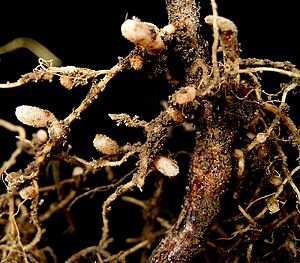
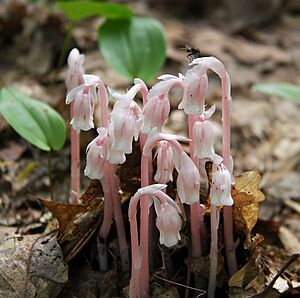
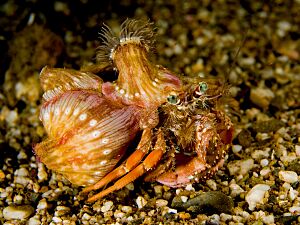
This type of symbiosis is called endosymbiosis, where one organism lives inside the other.
- Rhizobia: These are nitrogen-fixing bacteria that live in special bumps (nodules) on the roots of plants like peas. They help the plant get nitrogen from the air.
- Lichen: A lichen looks like a single organism, but it's actually a close partnership between a fungus and an alga (or a bacterium). The alga lives inside the fungus. The fungus needs the alga to survive, but the alga can live on its own.
- Mycorrhiza: This is a partnership between fungi and the roots of trees. The fungal threads (hyphae) help the tree get water and nutrients, and the tree provides food for the fungus.
- Bacteria in guts: Many insects and vertebrates (like cows or termites) have bacteria in their guts that help them digest plant material like cellulose. Animals usually can't break down cellulose on their own, so these bacteria are essential.
- Cells of all animals and plants: Scientists believe that the eukaryote cell (the type of cell all animals and plants are made of) evolved from ancient endosymbiosis. Tiny parts inside these cells, like mitochondria and chloroplasts, have their own DNA. This DNA is a leftover from when they were once separate bacteria that started living inside other cells.
Cool Examples of Symbiosis
Here are some amazing examples of symbiosis in nature:
- Clownfish and Sea Anemones: This is a great example of mutualism. Clownfish live safely among the stinging tentacles of tropical sea anemones. The clownfish is protected from predators because it has a special mucus that stops the anemone's stings. In return, the clownfish protects the anemone from other fish that might eat it. Clownfish waste also provides nutrients, and they can even help the anemone get more oxygen at night!
- Goby Fish and Shrimp: This is another mutualistic partnership. A goby fish and a shrimp often share a burrow in the sand. The shrimp digs and cleans the burrow, but it's almost blind and vulnerable to predators when outside. The goby fish acts as a lookout. If a predator comes near, the goby touches the shrimp with its tail. This signal tells both of them to quickly hide in the burrow.
- Ants and Aphids: Some species of ants act like farmers! They "farm" aphids. The ants protect the aphids from predators and even move them to better feeding spots. In return, the ants get a sweet, sticky fluid called honeydew that the aphids secrete after sucking sap from plants.
- Herbivores and Gut Bacteria: Many plant-eating animals, or herbivores, have special bacteria living in their guts. These bacteria help them digest plant material, especially cellulose, which makes up plant cell walls. Most animals can't digest cellulose on their own, so these bacteria are essential for them to get energy from plants.
- Barnacles and Whales: Barnacles are small crustaceans that attach themselves to the skin of whales. The barnacles benefit greatly by getting a mobile home, access to nutrient-rich waters as the whale swims, and a constant supply of food particles filtered from the water. The whale, being so large, is generally unaffected by the barnacles. They don't cause significant harm or provide any known benefit to the whale. A single whale can carry hundreds of pounds of barnacles, but due to their immense size, this weight is negligible to the whale.
- Remora Fish and Sharks: Remoras have a special suction cup-like organ on their heads that allows them to attach to the bodies of larger animals. The remora gets a free ride, protection from predators, and scraps of food left over from the shark's meals. The shark, in most cases, doesn't seem to notice or be affected by the remora.
- Cattle Egrets and Livestock: Cattle egrets are often seen walking among herds of large animals in fields. As the large animals move through the grass, they stir up insects like grasshoppers and beetles. The cattle egrets then swoop in and easily catch these disturbed insects for food. The grazing animals are generally unaffected by the birds' presence.
- Cuckoos and Other Birds: Cuckoos are famous for their unique reproductive strategy. Instead of building their own nests and raising their young, female cuckoos lay their eggs in the nests of other bird species. The host parents then unknowingly incubate the cuckoo egg and raise the cuckoo chick, often at the expense of their own offspring. Cuckoo chicks often hatch earlier and grow faster, sometimes pushing the host's own eggs or chicks out of the nest. The cuckoo benefits by saving energy on parental care, while the host parents waste valuable resources raising a foreign chick.
- Mistletoe and Trees: Mistletoe is a plant that grows on the branches of other trees. Mistletoe is a hemiparasite, meaning it can photosynthesize a little on its own, but it also taps into the host tree's vascular system (like its "blood vessels") to steal water and nutrients. The mistletoe benefits by getting easy access to resources, while the host tree can be weakened, especially if heavily infested, leading to reduced growth or even death in severe cases.
The Importance of Symbiosis
Symbiotic relationships are not just quirky natural phenomena; they are fundamental to life on Earth.
- They help maintain the balance of ecosystems. For example, mutualistic relationships like mycorrhizal fungi and plants are crucial for nutrient cycling and plant growth, which forms the base of many food webs.
- Symbiosis drives biodiversity by creating new niches and allowing species to adapt to different environments.
- These close interactions are powerful engines of evolution, leading to incredible adaptations in both partners.
- Many organisms simply could not survive without their symbiotic partners. Imagine a world without lichens, which are pioneer species that colonize barren land, or without the gut bacteria that help us digest food!
Key Concepts in Symbiosis
- Host: The larger organism in a symbiotic relationship, especially in parasitism and commensalism, that provides resources or a home for the other organism.
- Symbiont: The smaller organism in a symbiotic relationship.
- Co-evolution: This is a fascinating concept where two or more species evolve together, each influencing the other's adaptations. Many symbiotic relationships are perfect examples of co-evolution.
- Ectosymbiosis: When one organism lives on the outside of another, like head lice on humans.
- Endosymbiosis: When one organism lives inside the other, like tiny algae inside coral.
Interesting facts about Symbiosis
- The word "symbiosis" comes from ancient Greek words. Symbíōsis means "living with" or "companionship." It combines sýn (together) and bíosis (living).
- The term was first used by scientists like Anton de Bary in 1879 to mean "the living together of unlike organisms."
- Symbiosis is a very important force in evolution. Many species have evolved together over long periods, depending on each other.
- Many symbiotic relationships are between organisms from completely different kingdoms.
- Mimicry is a type of symbiosis where one species copies the look or behavior of another. This helps the mimic gain an advantage.
- Cleaning symbiosis is when one animal (the cleaner) removes and eats parasites or dead skin from another animal (the client). This often benefits both. The cleaner gets food, and the client gets rid of harmful parasites.
- Symbiogenesis is a fascinating idea about how complex cells, called eukaryotes (which make up plants, animals, fungi, and protists), might have formed. It suggests that the cell's nucleus might have come from a partnership between different types of bacteria.
- The biologist Lynn Margulis was a big supporter of symbiogenesis. She and her son, Dorion Sagan, famously said, "Life did not take over the globe by combat, but by networking."
Images for kids
-
In a symbiotic mutualistic relationship, the clownfish feeds on small invertebrates that otherwise have potential to harm the sea anemone, and the fecal matter from the clownfish provides nutrients to the sea anemone. The clownfish is additionally protected from predators by the anemone's stinging cells, to which the clownfish is immune. The clownfish also emits a high pitched sound that deters butterfly fish, which would otherwise eat the anemone.
-
Hermit crab, Calcinus laevimanus, with sea anemone.
-
Bryoliths document a mutualistic symbiosis between a hermit crab and encrusting bryozoans; Banc d'Arguin, Mauritania
-
Phoretic mites on a fly (Pseudolynchia canariensis).
-
Flea bites on a human is an example of parasitism.
See also
 In Spanish: Simbiosis para niños
In Spanish: Simbiosis para niños


